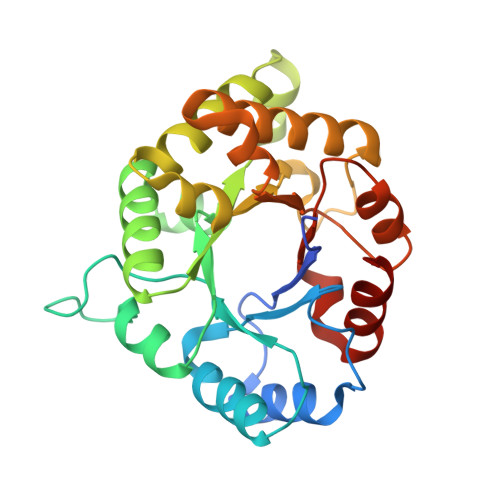Crystal structures of triosephosphate isomerase from methicillin resistant Staphylococcus aureus MRSA252 provide structural insights into novel modes of ligand binding and unique conformations of catalytic loop
Mukherjee, S., Roychowdhury, A., Dutta, D., Das, A.K.(2012) Biochimie 94: 2532-2544
- PubMed: 22813930
- DOI: https://doi.org/10.1016/j.biochi.2012.07.001
- Primary Citation of Related Structures:
3M9Y, 3UWU, 3UWV, 3UWW, 3UWY, 3UWZ - PubMed Abstract:
Staphylococcus aureus is one of the most dreaded pathogens worldwide and emergence of notorious antibiotic resistant strains have further exacerbated the present scenario. The glycolytic enzyme, triosephosphate isomerase (TIM) is one of the cell envelope proteins of the coccus and is involved in biofilm formation. It also plays an instrumental role in adherence and invasion of the bacteria into the host cell. To structurally characterize this important enzyme and analyze it's interaction with different inhibitors, substrate and transition state analogues, the present article describes several crystal structures of SaTIM alone and in complex with different ligands: glycerol-3-phosphate (G3P), glycerol-2-phosphate (G2P), 3-phosphoglyceric acid (3PG) and 2-phosphoglyceric acid (2PG). Unique conformations of the catalytic loop 6 (L6) has been observed in the different complexes. It is found to be in "almost closed" conformation in both subunits of the structure complexed to G3P. However L6 adopts the open conformation in presence of G2P and 2PG. The preference of the conformation of the catalytic loop can be correlated with the position of the phosphate group in the ligand. Novel modes of binding have been observed for G2P and 3PG for the very first time. The triose moiety is oriented away from the catalytic residues and occupies an entirely different position in some subunits. A completely new binding site for phosphate has also been identified in the complex with 2PG which differs substantially from the conventional phosphate binding site of the ligand in the crystal structures of TIM determined so far.
- Department of Biotechnology, Indian Institute of Technology, Kharagpur 721302, West Bengal, India.
Organizational Affiliation:


















